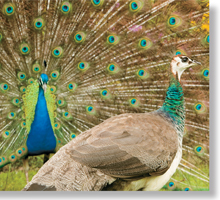 The Hardy-Weinberg principle predicts that five conditions can disturb genetic equilibrium and cause evolution to occur: (1) nonrandom mating; (2) small population size; and (3) immigration or emigration; (4) mutations; or (5) natural selection.
The Hardy-Weinberg principle predicts that five conditions can disturb genetic equilibrium and cause evolution to occur: (1) nonrandom mating; (2) small population size; and (3) immigration or emigration; (4) mutations; or (5) natural selection.
▸ Nonrandom Mating In genetic equilibrium, individuals must mate with other individuals at random. But in many species, individuals select mates based on heritable traits, such as size, strength, or coloration, a practice known as sexual selection. When sexual selection is at work, genes for the traits selected for or against are not in equilibrium.
▸ Small Population Size Genetic drift does not usually have major effects in large populations, but can affect small populations strongly. Evolutionary change due to genetic drift thus happens more easily in small populations.
▸ Immigration or Emigration Individuals who join a population may introduce new alleles into the gene pool, and individuals who leave may remove alleles. Thus, any movement of individuals into (immigration) or out of (emigration) a population can disrupt genetic equilibrium, a process called gene flow.
▸ Mutations Mutations can introduce new alleles into a gene pool, thereby changing allele frequencies and causing evolution to occur.
▸ Natural Selection If different genotypes have different fitness, genetic equilibrium will be disrupted, and evolution will occur.
One or more of these conditions usually holds for real populations. So, most of the time, in most species, evolution happens.

FIGURE 17–10 Choosing a Mate Random mating is one condition required to maintain genetic equilibrium in a population. However, in many species, mating is not random. Female peacocks, for example, choose mates on the basis of physical characteristics such as brightly patterned tail feathers. This is a classic example of sexual selection.
17.2 Assessment

-
Review How does natural selection affect a single-gene trait?
Compare and Contrast Compare directional selection and disruptive selection.
-
Review Define genetic drift.
Relate Cause and Effect How can the founder effect lead to changes in a gene pool?
-
Review What five conditions are necessary to maintain genetic equilibrium?
Infer Why is genetic equilibrium uncommon in actual populations?
Apply the Big idea
Do you think populations stay in genetic equilibrium after the environment has changed significantly? Explain your answer.

Table of Contents
- Formulas and Equations
- Applying Formulas and Equations
- Mean, Median, and Mode
- Estimation
- Using Measurements in Calculations
- Effects of Measurement Errors
- Accuracy
- Precision
- Comparing Accuracy and Precision
- Significant Figures
- Calculating With Significant Figures
- Scientific Notation
- Calculating With Scientific Notation
- Dimensional Analysis
- Applying Dimensional Analysis




